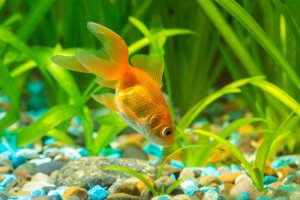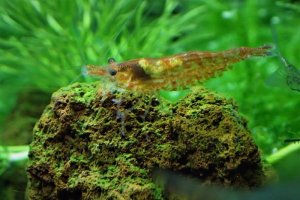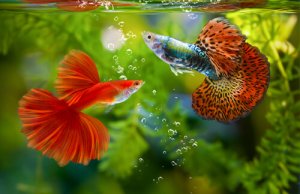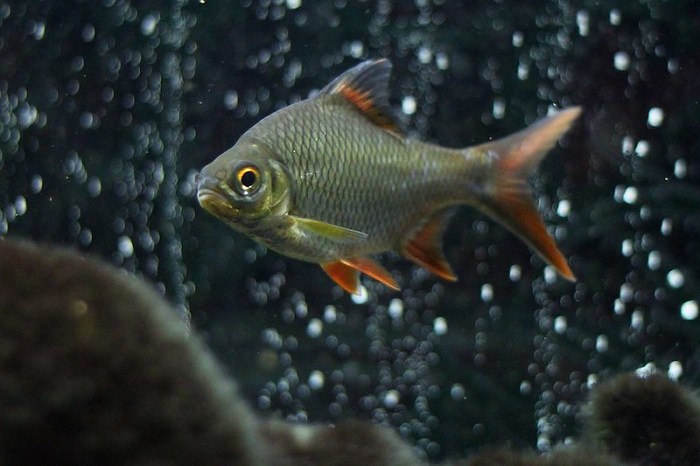
The Tinfoil Barb gets its name because it has shiny silvery scales that resemble tinfoil, Initially, it was only available in red, referred to as the redfin or red tail barb. Tinfoil Barbs grow pretty large in size and thus need plenty of tank space, and a large aquarium. They have a fairly moderate temperament and may nip at longer-finned fish, and eat smaller fish. Though they are herbivores, Tinfoil barb will occasionally accept meat-based foods.
Overall Tinfoil Barb are very hardy fish that are easy to care for by beginners, although they need to be kept in groups of four or more fish. Tinfoil Barb will likewise easily adapt to most water pH and temperature levels, which makes them easy to house with suitable tank mates of other species.
So, should you be interested in the Tinfoil Barb, you can follow for more care tips and facts, from our trusted resources.
Breed Overview
| Origin | South East Asia. |
| Lifespan | 10 – 15 years. |
| Size | Between 32 – 35cm (12 – 14 Inches). |
| Colors | Silver, Gold, Albino, Orange, and Glass. |
| Food | Herbivores in general, with some Omnivorous tendencies. |
| Tank Size | 75 Gallons (284 liters). |
| Temperament | Moderate to peaceful and Active Swimmers. |
| Water Temperature | Cooler Temperatures around 72 – 77 degrees Fahrenheit (22-25 Degrees Celsius). |
| Water pH | Neutral to Acidic pH 6.5 – 7.0 |
| Difficulty Level | Easy but expensive requirements. |
Species Summary
Let us start off with the Tinfoil Barb as a species and where it originates from. The Tinfoil barb is a tropical freshwater fish originating from Southeast Asia, from the Cyprinidae family, closely related to the common carp.
The Tinfoil Barb is distinguished by its shiny scales, red dorsal fin with a black blotch on top, and red pectoral, pelvic, and anal fins. The Caudal Fin will have a “white margin and black submarginal stripe” running along each lobe. The Tinfoil barb is a herbivore but will feed on small fish and insects, it is a schooling fish that needs to be kept in groups.
Be careful not to confuse the Tinfoil Barb with its smaller cousin the Red-Tail Barb which is much smaller in size, but has almost identical colors.
Color Variations
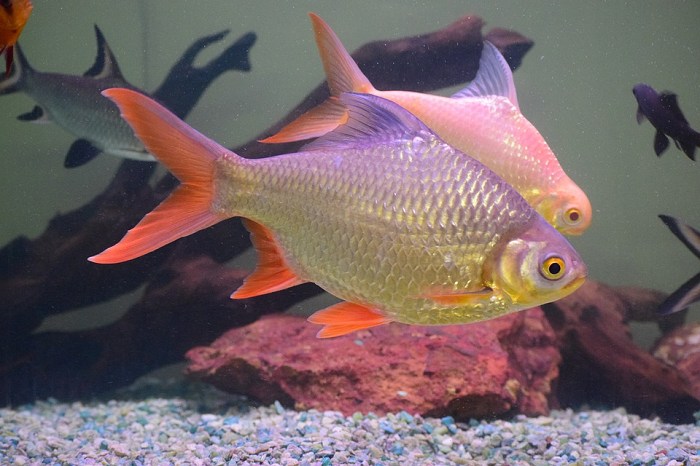
As mentioned, the original Tinfoil Barb will have a silvery color or a yellow-gold color, with red fins, though you do get some more color variations which include;
- Golden or Yellow Tinfoil Barbs – I have said that you get silver and gold Tinfoil barbs, the most common is the silver, though the gold or yellow has a slightly more golden cast and more translucent fins with red markings.
- Albino – The Albino Tinfoil Barb has a much lighter silvery, or golden color with red fins and red eyes.
- Glass – The Glass Tinfoil Barb is a completely translucent color with see-through fins. See-through silver no colors on fins
- Orange – The orange Tinfoil Barb is a very similar color to the Gold or Silver Barb with orange, rather than red fins.
Size And Lifespan Of The Tinfoil Barb Fish
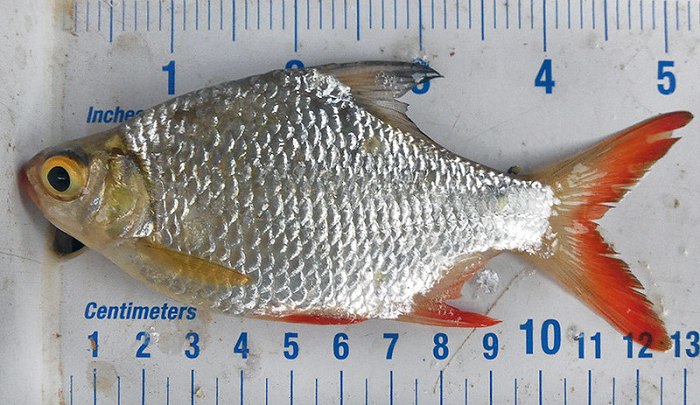
The Tinfoil Barb grows up to a very large size of 35 cm (14 inches) and will grow this size regardless of the size of your tank. It has quite a lengthy lifespan of between 10 – 15 years, provided that it’s kept in proper water conditions, and fed a healthy diet.
Temperament And Behaviour
Even though the Tinfoil Barb has such a large size, it is generally a peaceful fish, described as having a “moderate” temperament. They are mostly docile fish that will get along with almost any aquarium inhabitant, though it has been noted that they may nip at the fins of longer-finned fish, and eat fish that are much smaller than they are.
Despite their docile nature, Tinfoil Barb are very active and communal fish that will swim in larger groups, enjoying open spaces, and navigating their environment.
Caring For Tinfoil Barb Fish
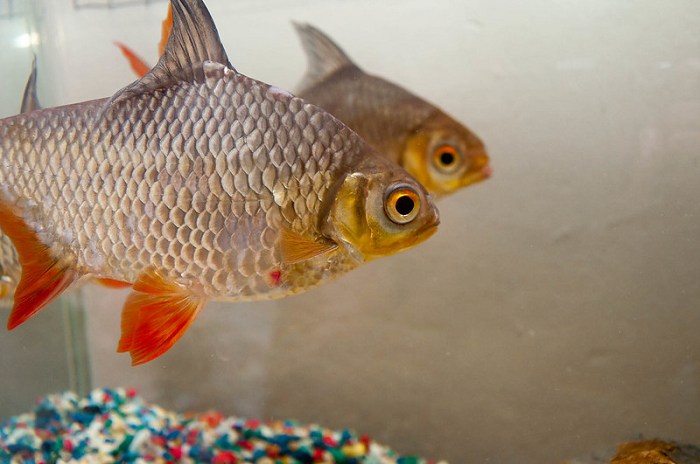
First of all the Tinfoil Barb is a Shoaling fish species, and must be kept in groups of four or more fish, otherwise, they may fight. They are sizable fish and will need a large tank.
The Tinfoil Barb has a substantial appetite and needs a good filtration system in their tank, and regular water maintenance, as they thrive in very clean water that is well-oxygenated.
Tinfoil Barbs are an ideal pet for beginners to intermediate Aquarists, they are mainly herbivores, though they may snack on smaller fish and meat-based foods occasionally.
One of the first factors to consider when considering keeping Tinfoil Tiger Barb is their Aquarium, which will have to be large and have good water conditions. So, let’s take a quick look at what they need for a thriving environment to live in;
Tank Set-Up
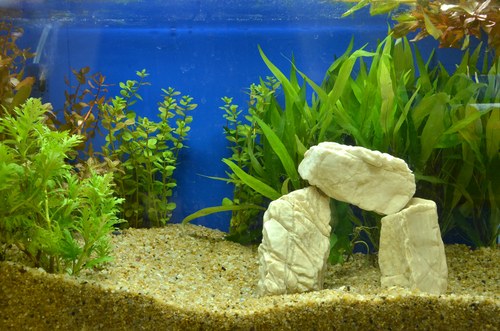
Setting up your tank is always loads of fun, but with Tinfoil Barbs it needs to be done with care and consideration. They are large fish, need ample space, and they are active swimmers. They do tend to destroy plants and decor in their tanks, and to push over plants and décor, thus, these should be chosen sensibly, along with the substrate for your tank.
Tinfoil Barbs are similarly notorious jumpers, and at their size, they can jump quite far, thus you will need a tank with a lid.
Tank Size
I must advise that tinfoil barbs, being such large fish, are expensive to keep in terms of tank size and feeding. Though they can easily live in a tank without décor they will be much happier with some plants and décor to keep them occupied.
The Tinfoil Barb requires a large tank of at least 75 gallons (284) liters, with plenty of swimming space, and your plants and décor placed along the edges of the tank.
Water Conditions
Tinfoil Barb is quite strict in tank conditions when it comes to water quality, as they need very clean, clear, and oxygen-rich water.
- Temperature – Temperatures of around 72–77 °F (22–25 °C), are suitable, though they can live in lower temperatures and are not very fussy in terms of temperature.
- Lighting – Tinfoil Barb needs low to moderate light and a clear indication of day and night. They look especially spectacular in a tank with dark substrate and overhead lighting, that will give their color a glimmering, and shimmery effect as the light reflects on them.
- Filtration – The water filtration system is absolutely essential, and you will need two filters in the large tank working in tandem with each other to keep the tank clean.
- Ammonia and Nitrites – Try to keep Ammonia, Nitrites, and Nitrates at 0 ppm, or as low as possible, as Tinfoil Barbs need very clean and clear water. You can do weekly water changes and regular maintenance, and use live plants to help keep nitrite levels low.
- pH Levels – Tinfoil Barbs in general are not too fussy with pH levels, though they prefer a slightly acidic to neutral pH of around 6.5 to 7.0.
- Water Hardness – Similarly water Hardness should not be much of a concern, as they can live in a water hardness of between 2 and 10dGH.
Tank Decoration
Regarding Tinfoil Barbs you should try to keep tank decorations as natural as possible, resembling their natural environment. A simulation of a realistic river bed, with a good background view of river shores, and stony substrate is ideal. Live tank plants are the ideal tank decorations, though should be chosen meticulously, as they may quickly be destroyed by your new fish friends.
Substrate – Tinfoil Barb is large and active, thus will easily knock over plants and decorations. Thus, I would choose a thick sand or gravel substrate, with some rocks and pebbles scattered smoothly. Large pieces of driftwood and rocks will likewise help you to firmly anchor plants and decorations.
Synthetic Plants – You can use synthetic plants that are of fake silk or softer plastic, as they may not get destroyed as easily as live plants.
Live Plants – As I might have mentioned, Tinfoil Barb is destructive when it comes to Live plants, they will push them over, and shred them to pieces, thus, it is advisable to choose more hardy plants for your tank, that are larger in size. It is best to keep plants and décor to the edges of the tank, and out of their swimming paths.
Here are a few plant types that you can consider;
- Anubias – They are popular and easy to care for, with thick and waxy leaves that are difficult for fish to tear apart.
- Java Ferns – Though controversial, older, and larger Java ferns are reasonably tough plants, and their sprouts can be a delicious snack for your Tinfoil Barbs.
- Bolbitis – The lush and textured green-leafed plant is hardy and appealing, and what makes it even better is that it grows quite large.
- Cryptocoryne – They are larger and hardy plants ideal for Tinfoil Barb and Cichlids.
- Ornaments – Generally it is best to stay clear of ornaments for Tinfoil Barb and rather opt for natural elements such as rocks and driftwood, resembling their natural habitat.
Introducing Your New Fish
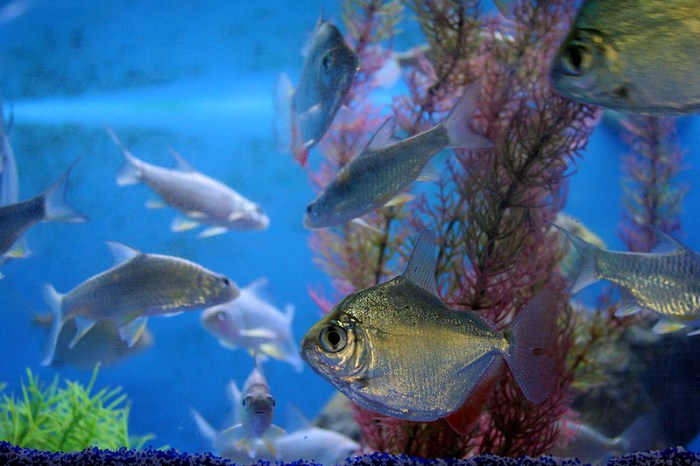
One of the best times in an aquarist’s journey from setting up the tank, and purchasing healthy fish is of course the last step, and that is placing your new friend inside its new home. But let us look a bit further into how you will proceed from choosing healthy fish to placing them in the tank.
Choosing Healthy Fish
You will need to choose at least four to six Tinfoil barbs to commune together as they are a shoaling species. A healthy fish will be active, swim around, and will show no signs of damage to the body or fins. The colors should be bright and bold with no white spots or patchy areas. It is very difficult to discern males from females, especially in juvenile Tinfoil Barbs, thus you will most likely get a mix of the two genders.
Adding Fish To The Tank
To place your fish into their new home you can follow these steps;
- Float the bag with your Barbs on the tank surface for around 20 minutes or more.
- Scoop out a cup of water from the bag and replace it with water from the tank.
- Repeat replacing the water every 10 minutes for around half an hour.
- Empty your fish into the tank, taking care not to add too much water from the bag, as it may be full of waste and ammonia.
Selecting Tank Mates / Companions For Your Barb Fish.
Your striking boldly colored Tinfoil Barbs could be a pleasure or an absolute horror to keep, depending largely on the personality of your group of barbs in comparison to that of the other species in your tank. So, think carefully when choosing tank mates that are of another species!
Barbs are generally flashy swimmers that will nip at the fins of slower-moving fish, and easily eat smaller fish. They have a huge appetite and grow very large, so smaller fish are not advised as tank mates.
A few recommended Tank mates are;
- Silver Dollar Fish – The Silver dollar fish resembles a silver dollar coin and is a freshwater fish that is low maintenance, with a long lifespan.
- Fire Eel – The Fire Eel is a larger species of Spiny Eel that is an omnivore, and relatively peaceful.
- Clown Loach – Clown Loaches have a colorful appearance and are bottom feeders that will be out of the way, and help to keep your tank clean.
- Bala shark – Bala sharks are similar shoaling fish and can be a theatrical addition to larger aquariums. They’re not true sharks but rather have a more shark-like appearance. They do exceptionally well in communal tanks, with other fish species.
Tank Maintenance
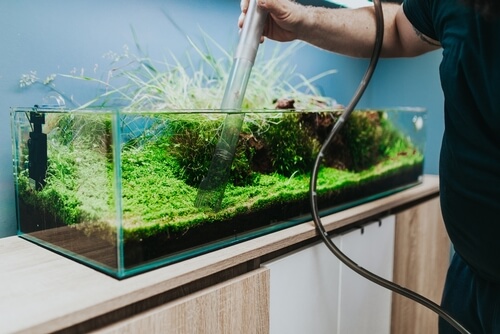
As the Tinfoil Barb requires crisp clean and clear water, regular tank maintenance is crucial. Weekly water changes should be done replacing at least 25 – 30 % of the tank water.
To replace tank water, you will need a suction tube to remove water from the bottom of the tank where most waste settles. Replace the water with new water that you have conditioned and heated to the correct pH levels and temperatures.
Investing in a tank vacuum for such a large tank will be ideal, you can also choose tank mates such as larger catfish and bottom-feeding fish, or large snails to help keep the tank clean. Live plants essentially help to oxygenate your tank and to clean the water.
Ensure that you remove any dead plants and leaves, as this may add to the waste. Rocks and tank décor need to be removed for cleaning.
Feeding Your Tinfoil Barb
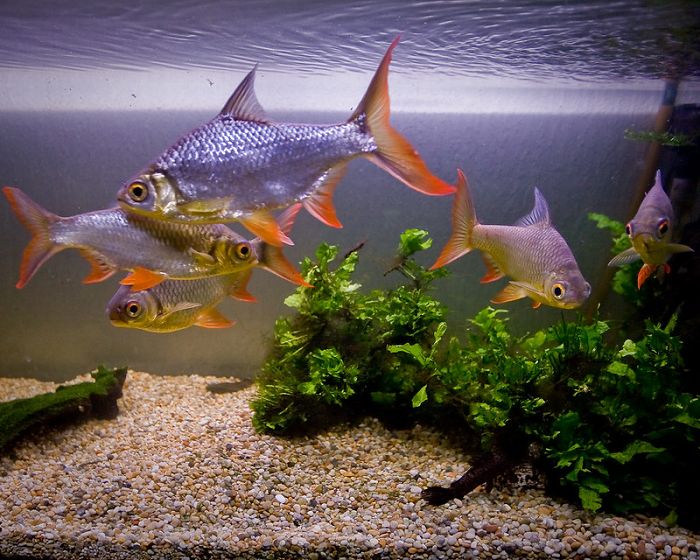
The Tinfoil Barb fish is an extremely greedy eater and will try to stuff its mouth with as much food as possible, eating almost anything you provide it with. Though they are herbivores Tinfoil Barb will occasionally also snack on meat-based foods and their smaller tank mates.
What To Feed
The Tinfoil Barb needs a healthy and balanced diet of dry pellets or flakes, and plant foods such as spinach, cucumber, lettuce, and other fruits and vegetables. Try to Blanch vegetables and cool them down before feeding them to your fish. Other than that, you can occasionally feed small insects or crustaceans such as brine shrimp, and blood worms.
How To Feed
Feed your Tinfoil Barb two to three times a day, with enough food for it to finish within 4 – 5 minutes. As they are large fish, they do have quite a healthy appetite. They can be gluttonous and have no sense of fullness, so beware of overfeeding.
Common Pests And Diseases
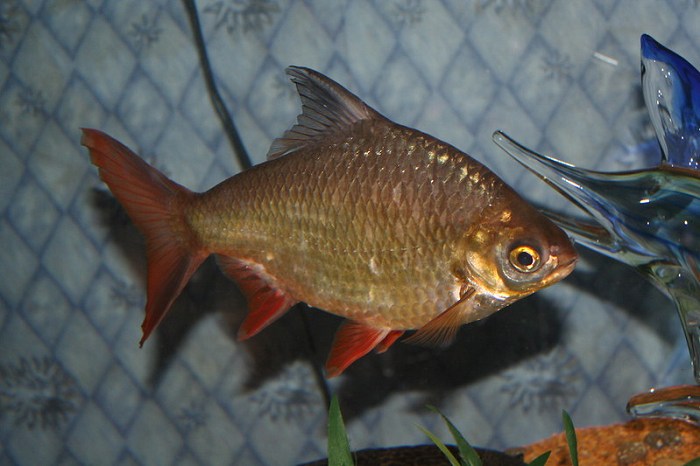
Unfortunately, Tinfoil Barb is vulnerable to numerous diseases, and pests such as viral and bacterial infections, and parasites.
These are a few of the more Common Issues you may find with Your Tinfoil Barb;
1. Swim Bladder Disease
- Symptoms and Causes: Swim Bladder Disease is caused by rapidly eating, overeating, or gulping air. Poor water conditions are also a culprit. Swim Bladder will cause your fish to float upside down or on its side, and to be lethargic.
- Treatment: Swim bladder disease is a bacterial infection that can be treated by quarantining your fish in a tank with clean water, and using antibiotics.
2. Fin Rot
- Symptoms and Causes: Fin rot is a bacterial infection caused by stress, poor water conditions, and other fish nipping at the fins of your fish. It causes discoloration of the fins and gives it a more ragged appearance.
- Treatment: To treat Fin rot you will similarly need to quarantine the fish in a tank with ideal water parameters. You can also use an antibacterial treatment to clear up the infection.
3. Ich
- Symptoms and Causes: Also called white spot disease is a parasite that causes white spots to appear on the fins and near the gills of your fish
- Treatment: It is important to keep fish with Ich separately as they can infect others. Clean the quarantine tank daily and keep water conditions at peak levels. You can use medication and water conditioners that are suitable specifically for Ich and parasites.
4. Epizootic Ulcerative Syndrome
- Symptoms and Causes: EUS is a fungal infection that fish get from an oomycete that is known as the Aphanomyces Invadans. It causes red spots to develop on the skin of your fish, which will eventually expand to lesions and ulcers, and in the end, start to affect internal organs.
- Treatment: treatment is quite tricky and there is no fast cure, especially if the symptoms of your fish are very severe. It is an infectious disease so the sick fish needs to be placed in a separate tank with “high-quality water” according to Wikipedia where you can read more about EUS. Aquarium Salts and Lime can be added to the water to help with treatment.
How To Breed Your Tinfoil Barb Fish
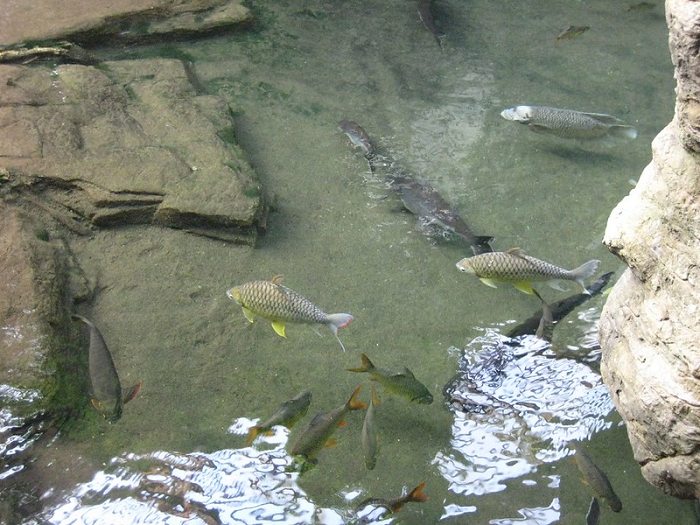
Breeding Tinfoil Barbs in an Aquarium is highly ill-advised because of their rapid growth and large size, and according to unverified sources, it is only done effectively in public aquariums. For successful reproduction, and care of eggs, and fry you will need a substantial size tank, or an “outdoor aquaculture” if you live in an area with a more tropical climate.
On the other hand, trying to determine the sex of Tinfoil Barb is almost impossible as there are no physical differences between the two, but if you read further I will explain how you can determine the sex of Tinfoil Barb.
Tinfoil Barb reaches maturity around one year of age, though Induced Spawning, which you can read about on the pages from the University of Hawaii, is done with fish two years and older.
Tinfoil Barb is an egg scatterer, meaning the female will scatter the eggs all over the breeding tank for the male to fertilize. Thus, it is also vital to ensure that the breeding tank has plenty of plants for eggs to attach to and small fry to hide between.
The adult fish need to be removed after spawning as they will eat the eggs and their young. The eggs should hatch within a day or two, and as soon as the fry becomes more independent you can start feeding them small crushed fish flakes. You will however need to rehome them as they will outgrow the breeding tank rapidly
Final Thoughts
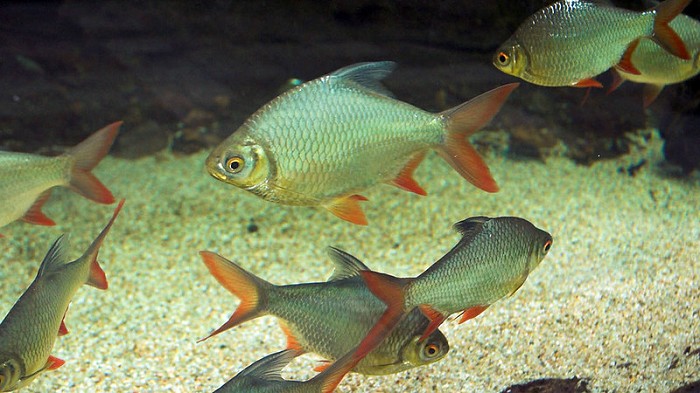
The Tinfoil Barb is a moderate temperament tropical fish that has silver or gold scales, with colorful fins and tail fins. It is a large fish, thus requires plenty of space and it is a shoaling fish, so four or more need to be kept in a community.
Tinfoil Barb can make some intricate and amusing pets, though they are quite difficult to breed, and to distinguish male from female. All in all, the Tinfoil Barb is a hardy tropical fish that requires very clean water, however, that is also adaptable to pH levels and temperatures. It is an easy fish species to keep if you have the space and the investment of a large aquarium.


